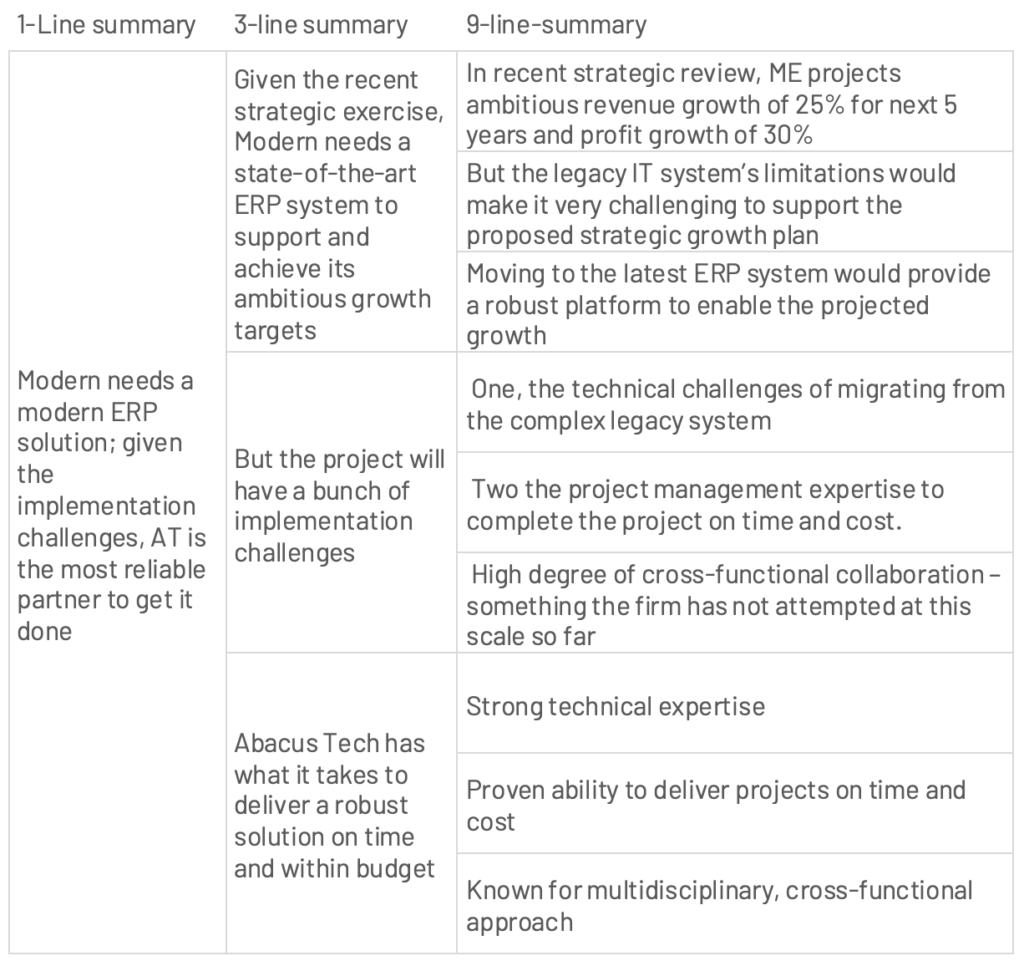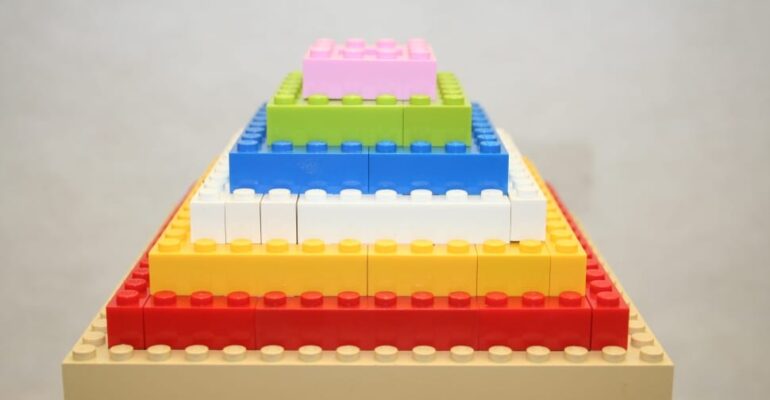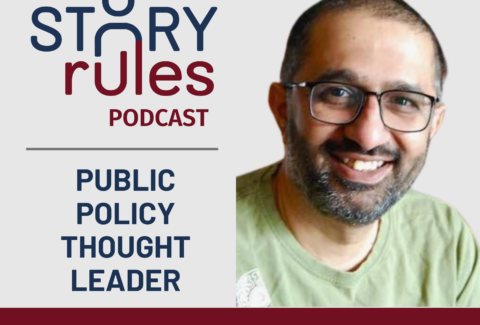A story structuring framework as easy as 1-3-9
“All of this is great Ravi. But we hardly get any time to prepare our presentations. If we had ample time, we could apply all the storytelling techniques you teach. How do we use them when the deadline is one day?”
This is one of the most common pushbacks1 I get when I share some of the storytelling techniques with my session participants.
And I think it is easily addressable.
The key trick? If you want to start on a presentation, don’t start with the presentation.
Start with a one-page summary using something I call the 1-3-9 Story Spine.
It’s a framework that:
– Clarifies your thinking
– Ensures that your content is comprehensive and in the right flow
– Enhances your audience’s understanding of the content, and most importantly,
– Saves you time and effort by avoiding the creation of unnecessary slides
Intrigued, much? Let’s dive in.
The 1-3-9 Story Spine: The Pyramid Principle applied on one page
I’ve written about the primacy of the Pyramid Principle as a powerful tool for clear thinking and communication. Here’s a post introducing the concept and here are some examples of how it is applied in several high-stakes communication situations: shareholder letters by Jeff Bezos and Warren Buffet and a deck by Sequoia Capital.
The 1-3-9 Story Spine is the most simplified version (see footnote 2) of the Pyramid Principle.

It forces you to put down the entire story (of your business review, product pitch, cost-reduction proposal etc.) into this simple 1-page framework.
Applying the 1-3-9 Story Spine to a movie script!
Let’s take an example. For keeping it fun, I’ll take a movie script. I’m going with the blockbuster Bollywood hit, ‘Dangal’.
First, up – you need to list down all the “messages” – in this case, the detailed events of the movie:
– The main character, Mahavir Phogat, is a National level winning wrestler based in Haryana, who has a major life regret – that he could not win an international medal
– He thinks his son/s will win the medal for him
– But all his 4 kids are daughters – he resigns himself to a medal-less life
– Due to a neighbourhood incident where his two elder daughters (Geeta and Babita) beat up a few boys, he realises that daughters can also win medals
– He starts a strict diet and exercise regimen for his 2 elder daughters
– In doing so, he fights several challenges: at home with his wife and daughters; from society and the wrestling community; also grapples with conflict with his daughter/s
– His eldest daughter, Geeta enrols in the prestigious National Sports Academy and grapples with tough coach
– She gets secret coaching from her father and manages to reach the finals of an international tournament
– She wins the final match overcoming challenges from a tough opponent; challenges with her coach; and her own self-doubt
Alright, that’s quite a bit.
Now let’s figure out a 3-part summary of this entire script.

Note how the above table makes reading easier – especially if you read just the “3-line summary” column, you get the gist of the story in just three sentences. Each of those three sentences are further elaborated in the “9-line summary” column.
Of course, we wouldn’t stop at three. We have a final sentence to write: the one-line summary:

There you have it: The 1-3-9 Story Spine, which is a simplified and practical version of the Pyramid Principle.
Applying the 1-3-9 Story Spine for a business presentation
“Sure, we might be able to use something like this for a movie script. But does it work for a business presentation”, you might wonder.
Consider the following case study:
Abacus’ Pitch to Modern Enterprises
Abacus, a leading consulting firm is pitching its services for ERP implementation support to a client Modern Enterprises (Modern). Abacus believes that its key strengths are:
– Strong technical expertise
– Proven ability to deliver projects on time and cost
– Known for a multidisciplinary, cross-functional approach
Modern is a leading consumer durables company, growing at a revenue growth of 15% over the last 5 years. After a recent strategic review exercise, it has revamped its strategy and projects ambitious revenue growth of 25% for the next 5 years and profit growth of 30%.
Currently Modern uses a legacy IT system, which has been functional for the last 10 years. Abacus believes, however, that the current system’s limitations would make it very challenging to support the proposed strategic growth plan.
Abacus is recommending a move to the latest ERP system that would be robust and aid the projected growth in a smooth manner.
Modern’s CTO Anu Shah realises the need to revamp their system… But she has a bunch of concerns. One, the technical challenges of migrating from the complex legacy system. Two the project management expertise to complete the project on time and cost. She also believes that the project will need a high degree of cross-functional collaboration – something the firm has not attempted at this scale so far.
How should Abacus pitch its story to Modern?
Before reading ahead, you could attempt to create your own version of the 1-3-9 Story Spine with the case study above.
And then you can compare your solution with this one that I crafted:

Much easier to read, right? That’s the power of the 1-3-9 Story Spine.
Some caveats
While the final one-sentence summary is a critical requirement of this framework, the numbers 3 and 9 are guidelines, not edicts inscribed on stone!
You can use 4 buckets instead of 3 – which might translate to 10-12 next-level statements. But, don’t take it to a 1-7-21 structure! Seven buckets are too many for a person to absorb and remember.
Plus, there’s a lot of evidence that supports the Rule of Three: 3 is a “goldilocks” number that is just right: Not too many to remember and not too little to be seen as lacking depth.
Converting the 1-3-9 into an Executive Summary
Ok, so you might be thinking next: Where does the 1-3-9 actually come in the overall presentation you have to create?
Simple – as your Executive Summary slide.
I recommend using the following format for an Executive Summary (instead of the typical 10-bullet point list or 4-5 dense paras of text).

Each of the buckets in the summary above would be a separate section in the presentation.
How will the Abacus Tech case look in this Executive Summary format? Let’s take a look:

Each of the statements in the “9” section above can become the message of a separate slide.
Summary
The 1-3-9 Story Spine is a simple yet powerful tool that:
– Clarifies your own thinking and improves your story’s comprehensiveness and flow
– Ensures that the audience “gets” what you have to say with minimal time and effort
– Saves you time by focusing on only the most critical messages, thereby ensuring that you don’t have to waste time creating unnecessary slides and other content
In further posts, I will share:
– More examples of the use of this framework
– Some additional tips and concepts to keep in mind while crafting this framework.
– How to use this as a starting point to craft your storyboard and create your final slides
Meanwhile, let me know if you have used the 1-3-9 Story Spine (or a version thereof) in one of your own presentations!
Featured Image Credit: From Peak PX
Notes:
1. To be clear, there are two (incorrect) assumptions in the common complaint of “never have enough time to apply all the storytelling techniques that I most definitely would have otherwise applied”:
– Time is not always short: Not all high-stakes communications are to be created and delivered on a short deadline. Sure we will get last-minute requests on several occasions, but most critical presentations (especially with senior audiences) are scheduled well in advance
- We revert to old habits even when we have time: We are creatures of habit and even when we have a lot of time, we end up creating presentations the same way we have been doing for years (as data dumps, without using storytelling techniques).
2. I came across this as a blank one-page format in a storytelling workshop conducted by Emily Hennessey at British Council, Pune as a way to summarise a children’s story she shared. I have adapted it for a work context and named it the 1-3-9 Story Spine.








